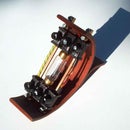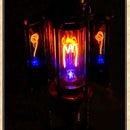Introduction: The Steampunked Torch of Progress
Here is my latest project „The steampunked torch of progress“.
The idea to create this steampunked torch as a scepter of victorian progress came to my mind as I looked at some old pictures showing some allegoric statues (see next step).
All parts can be easily build together with only some screws and a little bit of resin.
For building the technical equipment I used this instructable: High-voltage-power-supply-for-Nixies-CFL-Neon-Glow-Bulbs
To get a short impression please watch this small video:
Now let us start with this instructable
Have fun
Yours Aeon Junophor
Step 1: Historical Background (short)
Before we start let me explain one or two things:
As a real steampunker I love this retro-futuristic style based in the victorian era (1837-1901) as you know. This is my favourite century with its technical inventions and new machines powered by steam and electricity.
In this time a lot of allegoric statues like the great statue of liberty had been build.
Also the new power called „electricity“ had its allegoric expression as you can see at this picture.
The torch, mostly used as a scepter of the goddes is a symbol of the technical progress which enlightens the darkness and brings wealth and hope.
These old pictures inspired me to create the Junophor steampunked torch of progress.
Step 2: Parts of the "torch-scepter"
The torch consists of only four parts
First an old , small handlamp made of bakelite and metal,
than an edison "centra-socket E27" as the top,
some copper and brass tube parts from the garbage box of a plumber
and at last a yellow marble made of glass.
Step 3: Preparing the Flickering Bulb
To build in the bulb it is neccessary to cut of the E14 socket. Please do it very carefully, otherwise you migth cut of the small wires, or damage the resistor. Also the glassbulb filled with neongas could be damaged and then the bulb wo´t work anymore. I did it best with a small saw. Before yo start to put of the socket you have to desolder the wire to the bottom contact of the socket.
Solder two new small wires to the wires of the bulb.
Next you have to insulate the two wires of the bulb with a shrinking hose. A smaller one for the one wire and a bigger one for the other wire wihich is connected to the resistor.
The whole "new bulb" is now placed in the middle of a red vulcanized fiber plate which has to fit in the cap. Fix the bulb with some spots of resin at the backside.
Step 4: The Switch
There are two small holes in the bakelite holder where the former contacts hd been screwed. I made one hole a little bigger so that a new switch fit in. I iused some resin to fix the switch in its new position.
Step 5: The Electric Parts
To let the flame flicker I took the electronic parts from the flash of a disposal camera and worked on it as you can see in this instructable.
The most difficult thing was to reduce the circuit board in such a way that it fits in and also work without a problem.
As power supply the torch works with two AA-batteries inside the copper and brass tube. The two contacts are made of brass screws and a spring. A small piece of wood hold the batteries at the right position inside the copper tube.
I hope you enjoyed my project.
Thanks for following and have fun
Yours Aeon Junophor

Participated in the
Instructables Design Competition

Participated in the
Make It Glow













